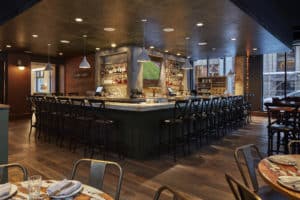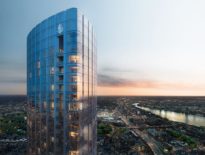
A boutique hotel designed by Arrowstreet in Boston contains a 2,000-square-foot restaurant and L-shaped bar connecting to the hotel lobby, creating informal interaction spaces for locals and visitors.
Changes and trends in the hotel industry are far-reaching and impacting all aspects of hotel design, development, and operation. Over the past 10 years, hotel chains have been divesting themselves of their real estate portfolios. The “asset-light” approach has allowed the major hotel companies to retool their businesses towards the management of operations.
This trend, while not new, continues to reshape the hotel industry and hotel development in general. Hotel companies are leveraging their expertise and focusing on operations, reservations, and design, with real estate development and ownership being provided through a variety of approaches including REIT’s, private investor groups or individuals. This change allows for a focus of specialization that supports the rapid evolution of the hotel industry.
Visitor Experiences are Personalized Using Data
Historically, service has been at the heart of the hotel industry – with personalization only available at the uppermost levels of hotel luxury, where the staff to guest ratio is the highest. However, today with the proliferation of lifestyle brands, that level of customization is expected across the spectrum of hotel types.
In the age of social media, data is being collected to curate experiences tied to personal preferences. The larger hotel chains have been using this information to develop new brands with design features and aesthetics tailored to specific groups of travelers. Brands are using data-driven personalization to accommodate each unique visitor’s needs from express check-in to curated experiences such as recommendations for craft breweries, cultural events and restaurants.
The partnership ecosystem makes it easy for us to connect with our favorite brands via our smartphones, and hotels are no exception to this trend.
Locally Authentic Brands are Impacting Design
Many people no longer choose hotels solely on brand loyalty or price. Instead, travelers are looking for hotels that act as local ambassadors with original designs and local products.
Equinox, with its new hotel at Hudson Yards, is designed and marketed (of course) around fitness. The Hotel Casa Camper (owned by the Spanish luxury shoe brand, Camper) has opened boutique hotels in Barcelona and Berlin. The design is ecologically-minded, centered around natural light, views from every room and a connection to the urban fabric of their cities.
In Detroit, Shinola, renowned for their “timeless, well-designed goods” including bicycles, watches and leather goods, has opened their first hotel. The hotel design reflects the Shinola brand, locally made products, and the rich history of Detroit.
Consumers are increasingly basing their choices on considerations of authenticity and social responsibility, and there is an expectation that all businesses (including hotels) must move beyond green-washing towards a more sustainable future.
Hotels are expected to be built to higher performance standards that lead to lower operating costs and less environmental impacts. Healthy materials and finishes – featuring non-toxic and non-allergenic materials – are being used in construction and day-to-day operations including with organic linens, furnishings and cleaning protocols, supporting smaller environmental footprints. At Arrowstreet, we are one of 56 firms (and growing) in the country who have signed on to the Materials Pledge to specify holistically optimized materials that are healthier and more equitable.
Arrowstreet is also using prefabricated building facades for faster on-site construction, including a recently-completed a 163-room boutique hotel with a proprietary panel system manufactured offsite. Ninety-two panels were then installed within a tight urban job site in under two weeks. In addition to saving time and costs, the offsite production of the facade allowed for a higher level of quality control. Prefabrication has even made modular hotel rooms possible, whether in remote locations where the building is more complex or to create a “pop-up” or “pod” hotels to support events like a concert or festival.

David Bois
Flexible Spaces and Curating Convergence
The convergence of building uses has moved into the hospitality sector.
There is no longer a one-size-fits-all mentality to guestroom design. Varied room sizes and offerings, such as extended stay rooms, are mixed with more traditional double and king rooms. Smaller guestrooms are more common, giving way for larger social/public spaces. The hotel lobby is the epicenter of activity, providing co-working space, modern technology, and one-of-a-kind food and beverage offerings. Smaller restaurants run by local chefs and restaurateurs – reinforcing the local authenticity of the property – now spill into the hotel lobby “living room.”
In Boston, Arrowstreet recently completed a boutique hotel with a connecting 2,000-square-foot restaurant that opens into the hotel lobby. The focal point of the restaurant design is an L-shaped bar that brings locals and visitors together for informal interaction.
Transforming the Guest Experience Using Augmented Reality
At the forefront of the integration of technology into guest experience, hotels are implementing augmented reality to create personalized, unique experiences for their guests.
At the hub hotel chain in the United Kingdom, guests are encouraged to use their smartphones to scan stylized map wall coverings in their rooms. These maps come to life to provide information on local attractions they can visit during their stay. The Best Western Kelowna in British Columbia, guests can participate in a “gamified” augmented reality (AR) scavenger hunt – think “Pokemon Go meets Canadian wildlife!” There are also rumors that recent Disney patents are hinting at a Star Wars AR experience for the upcoming Star Wars Hotel at Disney World and Disneyland.
As the adoption of wearables continues to gain traction, hotels have the opportunity to engage their guests in ways never before possible.
David Bois is a principal at Boston-based architects Arrowstreet.





